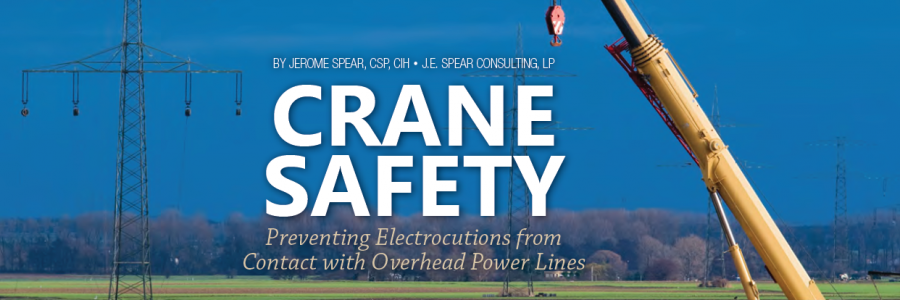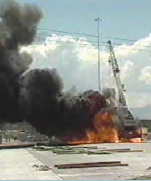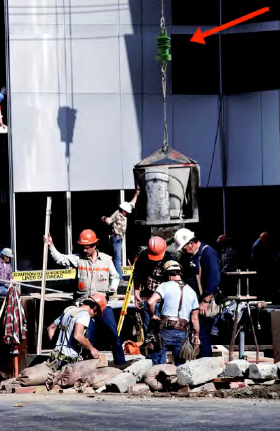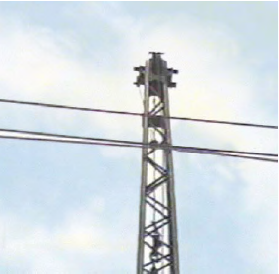
Cranes and Overhead Powerlines

Case 1: A 28-year old construction worker was holding onto a steel ladder being
moved by a telescoping boom crane. As the crane’s boom was swung in the direction of 7,200 volt power lines, the cable contacted the lines and the worker was electrocuted.
Case 2: A co-owner of a steel erection company and three workers were using
a telescoping boom crane to move a section of a steel framing member at the
construction site of a commercial storage shed. As the section was moved, it came in direct contact with a 23,000 volt overhead power line. Two of the three workers who were in direct contact with the load were electrocuted while the third received serious electrical burns.
Case 3: A construction company was in the process of laying concrete water pipe with a crane. As workers were placing support timbers beneath the crane’s outrigger pads, the operator began extending the crane boom for the next lift when the boom came into contact with a three-phase 13,800 volt overhead power line. One worker touching an outrigger of the crane was electrocuted.
As described by these case studies, contacting energized power lines may result in one or more fatal electrocutions, serious burns, and/or damaged equipment. The most common cause of crane-related fatalities is contact with overhead power lines. These electrocutions account for 32 percent of crane-related fatalities. Half of these electrocutions were associated with the crane boom or cable contacting an overhead power line, while others involved a power line coming into contact with unspecified parts of the crane (McCann, Gittleman, & Watters, 2008). Based on CPWR, The Center of Construction Research and Training’s review of crane-related fatalities that occurred from 1992 to 2006, the activities performed by construction workers when electrocuted by overhead power lines are categorized as follows:
Activity of Construction Workers Electrocuted
by Overhead Power Lines, 1992-2006

* Includes seven deaths of operators who jumped from crane.
** Includes six deaths of workers on foot near crane
Source: U.S. Bureau of Labor Statistics Census of Fatal Occupational Injuries
Research File (McCann, Gittleman, & Watters, 2008)
The Occupational Safety and Health Administration (OSHA) revised its requirements for working around over-head power lines and are contained in its Final Rule for Cranes and Derricks in Construction that was published in the Federal Register on November 8, 2010. OSHA determined that a more systematic, proactive approach to preventing power line contact was needed. This article discusses measures to prevent contacts as well as what to do if contact is made with an over-head power line.
ASSESS THE HAZARD
Prior to beginning operations, a hazard assessment inside the work zone must be performed. The hazard assessment must:
1. Identify the work zone and assess it for power lines. Determine how close the crane could get to them. The employer has an option of doing this assessment for the area 360 degrees around the crane or for a more limited, demarcated area.
2. If the assessment shows that the crane could get closer than a trigger distance – 20 feet for lines rated up to 350 kV (50 feet for lines rated over 350 kV) – then requirements for additional action is triggered.
ELIMINATE THE HAZARD
The first option if operations involving cranes (or other high-reaching equipment) will be performed near overhead power lines and the minimum clearance distances, as specified by OSHA, cannot be maintained is to de-energize and visibly ground the power line(s). By eliminating the source, the hazard of electrocution is eliminated. This must be coordinated with the utility company or owner of the line. The line owner may need several weeks to comply with the request, so the work should be planned appropriately. Only authorized personnel may de-energize a power line. All power lines shall be presumed energized unless the utility owner/operator confirms that the power line has been and continues to be de-energized and visibly grounded at the worksite.
If the power line cannot be de-energized for the duration of the work, another option is to move the line so that the line’s minimum clearance distance can be maintained. Like de-energizing the line, only the company who owns the line may move it. Again, the line owner may take several weeks to comply with the request.
KEEP YOUR DISTANCE
OSHA’s requirements regarding working near overhead power lines with cranes and other high-reaching equipment are straightforward. For lines 50 kilovolts (kV) or less, the operator must keep all parts of the crane or other high-reaching equipment at least 10 feet away from all power lines. For lifting equipment, this also includes any load being carried. This minimum clearance distance is a buffer zone that must be kept between the equipment and overhead lines. In other words, the minimum clearance distance is the minimum distance that is allowed from any part of a crane or other high-reaching equipment to an overhead power line.
If the lines are greater than 50 kV, then the line’s minimum clearance distance must be increased according to Table A of 29 CFR 1926.1408, Power Line Safety (Up to 350 kV) – Equipment Operations. Distribution lines are typically 50 kV or less, whereas transmission lines are typically greater than 50 kV. Distribution lines are the most common lines used by utilities. To determine the voltage rating of the power line, contact the utility company. If you still cannot determine the voltage range then keep at least 45 feet away.

Table A: Minimum Clearance Distances (29 CFR 1926.1408)

PREVENTING ENCROACHMENT OR ELECTROCUTION
If any part of the equipment, load line, or load (including rigging and lifting accessories), while operating up to the equipment’s maximum working radius in the work zone, could get closer than the minimum approach distance of the power line permitted in Table A (1926.1408), the following precautions shall be followed:
- Conduct a planning meeting with the operator and other workers who will be in the area of the equipment or load to review the location of the powerline(s), and the steps that will be implemented to prevent encroachment/electrocution.
- If tag lines are used, they must be non-conductive. “Tag lines” is defined as a rope (usually fiber) attached to a lifted load for the purposes of controlling or used to stabilized a bucket or magnet during material handling operations. Thus, one end of the tag line is attached to the load and the other end is held by an employee who controls the load’s motion by exerting force on the line. If the equipment or load were to make electrical contact with a power line while an employee was holding a tag line that was able to conduct electricity, the employee could be electrocuted. The requirement that the tag line be nonconductive is designed to protect against such an event. “Nonconductive” means the object in question has the property of not becoming energized (i.e., it has high dielectric properties offering a high resistance to the passage of current under the conditions of use). In practice, under dry conditions, nonmetallic fiber rope typically satisfies the definition of nonconductive.
- Erect and maintain an elevated warning line, barricade, or line of signs in view of the operator, equipped with flags or similar high-visibility markings, at 20 feet from the power line or at the minimum approach distance under Table A. Preferred methods of barricading are to erect temporary fencing and/or place equipment or storage containers at the minimum distance barrier line to prevent equipment movement within the encroachment zone; however, such boundaries must still be marked with flags, a warning line, and/or signs that limits all crane movement. If the operator is unable to see the elevated warning line, a dedicated spotter must be used.
In addition to the above, at least one of the following measures must be implemented: proximity alarm, dedicated spotter, range control device, range of motion limiting device, and/or insulating link. The advantages and limitations of these additional devices or safeguards are discussed below.
PROXIMITY ALARM
Proximity warning devices are designed to warn the crane operator when he/she moves any part of the boom too close to an overhead line. The device must be listed, labeled, or accepted by a nationally recognized testing laboratory (NRTL). The device should be set to give the operator sufficient warning to prevent encroachment.
It is possible to get false readings with these devices. The National Institute of Occupational Safety and Health (NIOSH) conducted a study that was published in January of 2009. This study tested the efficacy of two proximity alarm models under various simulated construction conditions. The study showed that the accuracy of the proximity alarms could be adversely affected by such factors as:
1. Operating the equipment with a boom angle and length significantly different than that used for the device’s last sensitivity adjustment and
2. Operating the equipment on sites with multiple overhead power lines, especially where those power lines have differing voltages or involved intersecting installations (Homce, Cawley, & Yenchek, 2008). Due to these limitations, the preamble to OSHA’s Cranes and Derricks in Construction Final Rule (2010) indicates that no proximity alarm can be listed, labeled, or accepted by a nationally recognized testing laboratory until the problems identified from the NIOSH study have been rectified.
DEDICATED SPOTTER
A dedicated spotter has the sole responsibility to watch the separation between the power line and the equipment, the load line, and load, and to ensure through communication with the operator that the applicable minimum distance is not breached. The dedicated spotter must be a qualified signal person; however, in situations where the equipment operator requires assistance of a signal person to provide signals related to maneuvering the equipment or load other than maintaining the required power line clearance distance, a different person must serve as the signal person. The dedicated spotter must be positioned so that he/she can effectively gauge the clearance distance from the power line; the spotter, where necessary, must use equipment that enables him/her to communicate directly with the equipment operator; and the spotter must give timely information to the operator so that the required clearance distance can be maintained.
RANGE CONTROL WARNING DEVICE
A range control warning device is a device that automatically warns the operator when to stop movement. This type of device can be set by an equipment operator to warn that the boom or jib tip is at a plane or multiple planes. For example, if an employer has chosen the option of maintaining a 20-foot distance from the power line, the range control warning device would then need to be set to alert the operator in time to prevent the boom, load line or load (whichever is closest to the power line) from breaching that 20-foot distance. As a practical matter, the device would have to be set to sound the warning more than 20 feet from the line since the operator will need some time to react and to account for the momentum of the equipment, load line, and load.
RANGE OF MOTION LIMITING DEVICE
A range of motion limiting device is a device that automatically limits the range of movement, set to prevent encroachment. Such a device can be particularly suitable for tower cranes, for which the swing angle can be programmed so that the operator cannot move the boom or jib past a certain range. While it may be more technically difficult to apply swing limitation devices for use in mobile cranes, the technology may develop so that they could be used in such cranes as well.
INSULATING LINKS The use of insulating links do not protect against encroachment but would provide protection to employees handling the load against electrocution in the event encroachment did occur. When using insulating links, it should be installed at a point between the end of the load line (or below) and the load. If a power line contact occurs, the linkage will prevent electricity from passing to the load. The entire structure of the crane, however, is not protected and will remain energized. Therefore, it is possible for the rigger to be protected, but any worker near the crane body may be electrocuted from the current passing through the ground. When insulated links are used, it is important to understand that the operator still shall not allow any part of the crane or load inside the power line’s minimum clearance distance. Also, insulating links must be listed, labeled, or accepted by a nationally recognized testing laboratory.
The use of insulating links do not protect against encroachment but would provide protection to employees handling the load against electrocution in the event encroachment did occur. When using insulating links, it should be installed at a point between the end of the load line (or below) and the load. If a power line contact occurs, the linkage will prevent electricity from passing to the load. The entire structure of the crane, however, is not protected and will remain energized. Therefore, it is possible for the rigger to be protected, but any worker near the crane body may be electrocuted from the current passing through the ground. When insulated links are used, it is important to understand that the operator still shall not allow any part of the crane or load inside the power line’s minimum clearance distance. Also, insulating links must be listed, labeled, or accepted by a nationally recognized testing laboratory.
ADDITIONAL SAFETY MEASURES
Additional safety controls may be instituted to further prevent and/or protect against power line contacts; however, the measures previously discussed must still be implemented if any part of the equipment, load line, or load (including rigging and lifting accessories), while operating up to the equipment’s maximum working radius in the work zone, could get closer than the minimum approach distance of the power line permitted in Table A (1926.1408).
INSULATED SLEEVES
Insulated sleeves can be attached directly to the power lines. The sleeve (made of non-conductive material) prevents physical contact between the crane and the power line. Only the utility company or the line owner’s representative may install insulated sleeves. These are designed for only brush contact; thus, the minimum distance must still be maintained even if the power line(s) have insulated
sleeves installed.
BOOM-CAGE GUARD
A boom-gage guard is a nonconductive gage that surrounds the boom of the crane. If a power line contact occurs with a boom cage guard, it will prevent the boom from becoming energized thus protecting all workers involved. The drawback of this technology is that it only protects the portion of the boom covered by the cage-guard. It is still possible for contacts to occur on other parts of the boom, the load line, and the load. Again, the operator must still maintain the minimum clearance distance of the power line as specified in Table A.
WHAT TO DO IF YOU HIT A LINE Power line contacts involving mobile cranes generally do not result in injuries to the crane operator. Injuries and death are often experienced by the riggers or other workers standing near the equipment. The reason for fewer injuries to operators is equipment design. If a contact occurs, the operator is at the same voltage potential as the equipment.
Power line contacts involving mobile cranes generally do not result in injuries to the crane operator. Injuries and death are often experienced by the riggers or other workers standing near the equipment. The reason for fewer injuries to operators is equipment design. If a contact occurs, the operator is at the same voltage potential as the equipment.
When the operator is isolated in the crane cab and contacts a line, the operator should wait in the crane and all other workers should stay away from the equipment. The line should be deenergized by the power company before the operator should leave the crane cab or until contact between the boom and the power line is broken. Only under extreme circumstances (e.g., fire), should the operator leave the equipment.
If the operator must leave the equipment, the operator must jump from the equipment and land feet together. Care must be taken not to touch any part of the crane and the ground at the same time. The operator must then shuffle his/ her feet in very small steps (or bunny hop) away from the crane. After a power line contact, the current flows outward from the point of contact through the soil in a ripple pattern. Areas of high and low potential circle the energized equipment like ripples in a pond after a stone hits the surface. If a person steps from an area of high potential to an area of low potential, electricity can flow through the person’s legs causing injury or death. The current flowing through the ground is also why other workers in the area of the energized equipment must stay away.
THE BOTTOM LINE
Contact with overhead power lines continues to be the most common cause of crane-related fatalities. Overhead power lines should be identified before any equipment arrives on site by conducting an assessment inside the work zone. If the assessment shows that the crane could get closer than a trigger distance i.e., 20 feet for lines rated up to 350 kV, then measures must be taken to prevent encroachment/electrocutions. The first consideration should be to have the power line(s) deenergized and visibly grounded. It this is not feasible, then other safety precautions must be taken to ensure the minimum clearance distance for the power line(s) is maintained. For power lines less than 50 kV, the boom and all parts of high reaching equipment must be kept at least 10 feet away. For power lines with greater voltages, the minimum clearance distance is increased. Additional safety measures can be taken to prevent contacts with overhead power lines; however, the bottom line is to “Keep Your Distance!”
REFERENCES
Homce, G. T., Cawley, J. C., & Yenchek, M. R. (2008). A Performance Evaluation of Two Overhead Power Line Proximity Warning Devices. Pittsburgh, PA: National Institute of Occupational Safety and Health (NIOSH).
McCann, M., Gittleman, J., & Watters, M. (2008). Crane-Related Deaths in Construction and Recommendations fortheir Prevention. Silver Spring, MD: CPWR, The Center for Construction Research and Training.
Occupational Safety and Health Administration (OSHA). (August 9, 2010). Cranes and Derricks in Construction; Final Rule. The Federal Register.

Share This Article!

